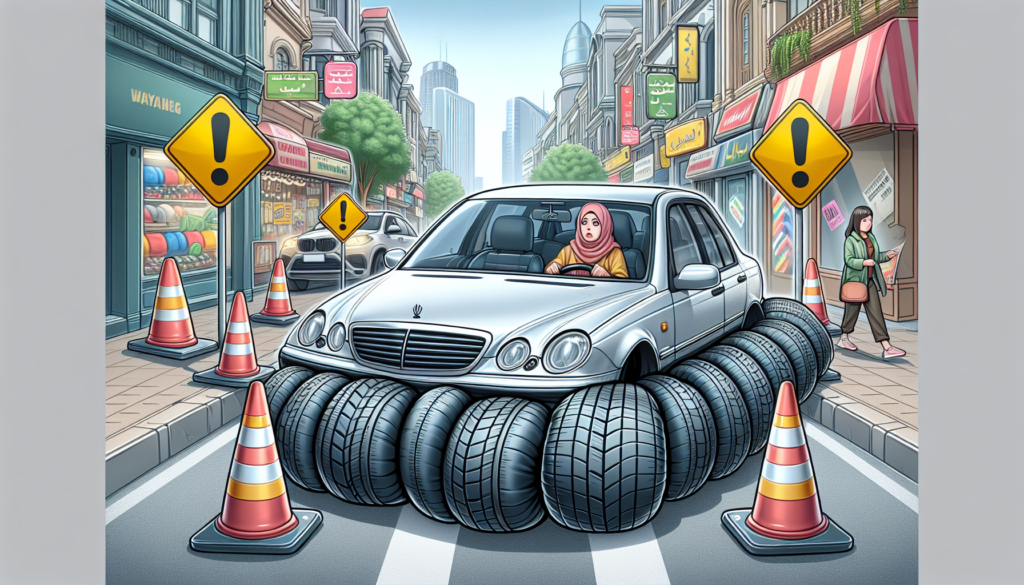Have you ever wondered about the potential risks of driving with overinflated tires? It’s a common question among drivers, and for good reason. In this article, we will explore the possible dangers associated with driving with tires that are overinflated. From decreased traction to increased risk of tire blowouts, understanding the risks can help you make informed decisions for your safety on the road. So, let’s dive in and explore the potential hazards of driving with overinflated tires!

Increased risk of blowouts
Tire bulging and weakening
When your tires are overinflated, the increased air pressure puts excessive strain on the tire walls. This can cause the tires to bulge outward, creating a weakened structure. The bulging can eventually lead to blowouts, where the tire suddenly bursts while you’re driving. This can be incredibly dangerous, especially at high speeds, as it can cause you to lose control of your vehicle and potentially lead to an accident.
Excessive stress on tire walls
Overinflated tires also place excessive stress on the tire walls. The increased air pressure stretches the tire walls beyond their designed limits, making them more prone to failure. This stress can weaken the structural integrity of the tire and increase the likelihood of a blowout. Regularly driving with overinflated tires puts you at a higher risk of experiencing this dangerous tire failure.
Reduced traction and stability
One of the dangers of overinflated tires is reduced traction and stability on the road. When your tires are overinflated, the smaller contact area with the road surface makes it harder for the tires to maintain grip. This can lead to decreased traction, especially in wet or slippery conditions. Reduced stability can also affect your ability to navigate corners or sudden maneuvers safely. It’s important to have the correct tire pressure to ensure optimal traction and stability while driving.
Reduced braking performance
Decreased contact area
Overinflated tires have a smaller contact area with the road surface, which can negatively impact your braking performance. When you apply the brakes, less of the tire’s surface is in contact with the road, reducing the friction needed to stop the vehicle effectively. This can result in longer stopping distances and increase the risk of rear-end collisions, especially in emergency braking situations.
Impaired grip on the road
Another risk of driving with overinflated tires is impaired grip on the road. The reduced contact area means that there is less tire surface available to provide the necessary traction to grip the road. This can lead to difficulty in maintaining control of your vehicle, particularly during sudden stops or when driving on slippery surfaces like ice or gravel. Impaired grip can compromise your ability to safely navigate turns and curves as well, increasing the likelihood of accidents.
Increased stopping distance
Due to the decreased contact area and impaired grip caused by overinflated tires, your vehicle’s stopping distance is likely to be longer. When you need to stop suddenly, whether due to an obstacle in the road or a sudden traffic situation, the increased stopping distance can greatly impact your ability to avoid a collision. A longer stopping distance reduces your margin for error, making it more challenging to respond effectively to potential dangers on the road.
Uneven tread wear
Center tread wear
Driving with overinflated tires can lead to uneven tread wear, with one common pattern being excessive wear in the center of the tire. The increased air pressure forces the tire to have more contact with the center of the tread, causing the middle portion to wear down faster than the rest of the tire. This can result in a loss of traction and compromised tire performance, particularly on wet or uneven surfaces.
Shoulder tread wear
Overinflated tires can also lead to uneven tread wear on the shoulders of the tires. The excessive air pressure causes the center portion of the tread to be lifted off the road, causing the outer edges or shoulders of the tire to bear the brunt of the contact. This uneven wear pattern can reduce the tire’s ability to grip the road surface evenly, leading to decreased traction and compromised handling.
Negative impact on tire lifespan
Uneven tread wear caused by overinflated tires can significantly reduce the overall lifespan of your tires. When certain areas of the tire wear down faster than others, it can lead to premature tire replacement. This translates to additional expenses for you as a driver. To ensure maximum tire longevity and value for money, maintaining the correct tire pressure is crucial.
Decreased fuel efficiency
Increased rolling resistance
Overinflated tires can contribute to decreased fuel efficiency due to increased rolling resistance. When the tires are overinflated, they become harder and less flexible, resulting in more resistance against the road surface. This can require your engine to exert more power, leading to higher fuel consumption. The increased rolling resistance negatively impacts your vehicle’s fuel efficiency, meaning you’ll be making more trips to the gas station and spending more money on fuel.
Increased fuel consumption
The increased rolling resistance caused by overinflated tires directly affects your vehicle’s fuel consumption. When your tires have excessive air pressure, your engine has to work harder to overcome the additional resistance and maintain the desired speed. This increased effort from the engine leads to higher fuel consumption. Consistently driving with overinflated tires can result in more frequent visits to the pump and unnecessary spending on fuel.

Reduced comfort and handling
Harsher ride quality
Overinflated tires can significantly impact your comfort while driving. The increased air pressure makes the tires stiffer and less flexible, resulting in a harsher ride quality. You may feel every bump and imperfection on the road more prominently, making your driving experience less comfortable, especially on uneven or rough surfaces. The reduced cushioning effect of overinflated tires can also make your vehicle more susceptible to road vibrations, causing additional discomfort for you and your passengers.
Greater vibration and noise
When your tires are overinflated, you may notice an increase in vibrations and road noise. The stiffer tires transmit more road vibrations directly to the vehicle’s cabin, making the ride feel rougher and noisier. These vibrations and increased noise can be bothersome and distract you from focusing on the road. In addition to reducing comfort, the greater vibrations can also affect your ability to have a smooth and controlled driving experience.
Increased risk of hydroplaning
Reduced ability to evacuate water
Driving with overinflated tires can increase the risk of hydroplaning, a situation where a layer of water builds up between the tires and the road surface, causing a loss of traction. Overinflated tires have a smaller contact area with the road, reducing their ability to effectively evacuate water. This means that even a relatively small amount of water on the road can create a hydroplaning risk, making it challenging to maintain control of your vehicle and increasing the chances of accidents, especially during rainy or wet weather conditions.
Loss of traction on wet surfaces
In addition to the increased risk of hydroplaning, overinflated tires also have reduced traction on wet surfaces. The reduced contact area and compromised grip make it more difficult for the tires to maintain traction on slippery roads. This can make it harder to accelerate, brake, or maneuver safely, increasing the likelihood of skidding and losing control of your vehicle. Ensuring your tires have the correct inflation level is crucial for maintaining traction and reducing the risk of accidents on wet roads.

Suspension and alignment problems
Excessive stress on suspension components
Driving with overinflated tires puts excessive stress on your vehicle’s suspension components. The increased air pressure causes the tires to become stiffer, transmitting more vibrations and road impacts to the suspension system. This increased stress can lead to premature wear and tear on the suspension components, potentially resulting in costly repairs or replacements. Maintaining the correct tire pressure helps ensure the longevity and effectiveness of your vehicle’s suspension system.
Uneven tire wear affecting alignment
Overinflated tires can also contribute to uneven tire wear, which can affect the alignment of your vehicle. As certain areas of the tire wear down faster than others, it can cause the vehicle to pull to one side, leading to misalignment. Misaligned wheels can result in uneven tire tread wear, decreased steering responsiveness, and compromised handling. Regularly checking and adjusting the tire pressure can help maintain proper alignment, protecting both your tires and your vehicle’s performance.
Damage to road surfaces
Increased pressure on the pavement
Driving with overinflated tires increases the pressure applied to the road surfaces. The smaller contact area results in a higher concentration of force on the pavement, which can cause damage over time. This increased pressure can lead to the formation of road ruts or cracks, especially on roads with weaker asphalt surfaces. The damage caused by overinflated tires not only affects road safety but also poses additional costs for repairing and maintaining road infrastructure.
Possible road rutting or cracking
The increased pressure on the pavement caused by overinflated tires can contribute to road rutting or cracking. Road rutting refers to the formation of grooves or depressions in the road surface, usually caused by the repetitive movement of vehicles. Overinflated tires can exacerbate the formation of road ruts, making road surfaces uneven and increasing the risk of accidents. Additionally, the increased pressure can lead to the development of cracks in the road, further compromising its integrity and durability.

Impaired handling in emergency situations
Reduced control during evasive maneuvers
In emergency situations where you need to make sudden evasive maneuvers, overinflated tires can impair your ability to maintain control of your vehicle. The decreased contact area and compromised grip make it more challenging to execute quick turns, swerves, or lane changes safely and effectively. Reduced control during evasive maneuvers can put you at a higher risk of colliding with obstacles or other vehicles, potentially causing severe accidents.
Difficulty in maintaining stability
Overinflated tires also make it more difficult to maintain stability during emergency maneuvers. The smaller contact area and decreased traction can make your vehicle more prone to skidding, sliding, or losing control when you need to make sudden and sharp maneuvers to avoid collisions. Difficulty in maintaining stability can have dire consequences, potentially leading to rollovers or multi-vehicle accidents. Proper tire inflation is essential for ensuring optimal stability and control during emergency driving situations.
Negative environmental impact
Increased tire waste
Driving with overinflated tires can contribute to increased tire waste. When tires wear unevenly or prematurely due to overinflation, they need to be replaced more frequently. This leads to a higher volume of discarded or wasted tires, placing a burden on waste management and recycling systems. By maintaining the correct tire pressure, you can help extend the lifespan of your tires and reduce unnecessary waste generation.
Elevated carbon emissions
The increased rolling resistance and decreased fuel efficiency caused by overinflated tires result in elevated carbon emissions. When your engine has to work harder to overcome the additional resistance, it consumes more fuel and releases higher levels of carbon emissions into the environment. Increased carbon emissions contribute to air pollution and climate change, negatively impacting both human health and the environment. Proper tire inflation plays a crucial role in reducing carbon emissions and minimizing your carbon footprint.
In conclusion, driving with overinflated tires poses various risks that can affect your safety, comfort, and the environment. The increased risk of blowouts, reduced braking performance, uneven tread wear, decreased fuel efficiency, reduced comfort and handling, increased risk of hydroplaning, suspension and alignment problems, damage to road surfaces, impaired handling in emergency situations, and negative environmental impact are all reasons why maintaining the correct tire pressure is essential. Regularly checking and adjusting your tire pressure to the manufacturer’s recommended levels can help ensure optimal tire performance, prolong their lifespan, and promote a safer and more eco-friendly driving experience.


